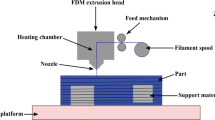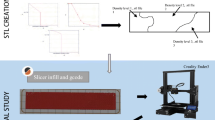Abstract
This research proposes and implements fuzzy goal programming (FGP) models to optimize the performance of rigid polyurethane foam (RPF) for four quality characteristics. At initial process factor settings, the RPF process was found incapable for density, shrinkage ratio, and expanding ratio. However, it was found highly capable for compressive strength at 10% deformation. As a result, costly nonconforming products were produced and delivered. For this reason, fuzzy goal programming models were proposed and implemented to determine the combination of optimal factors settings followed by confirmation experiments. The results showed that: (1) for density the capability index is enhanced from −1.72 to (0.66, 0.62, and 0.85) at lower, middle and upper optimal factor setting levels, respectively, (2) for compressive stress at 10% deformation, the capability index is improved from 5.32, to (6.98, 5.45, and 6.02), (3) for shrinkage ratio the process capability is highly capable; \({{\widehat{C}}_{pu}}\) becomes (4.56, 4.62, and 5.91), and (4) for expanding ratio the capability index becomes highly capable; \({{\widehat{C}}_{pu}}\), equals to (6.37, 6.30, and 6.88). Such improvements in process capability result in significant savings in quality, maintenance, and production costs. In conclusions, implementing fuzzy goal programming model is found an efficient technique to optimal RPF performance for four quality responses.






Similar content being viewed by others

References
Al-Refaie A (2013) A proposed weighted additive model to optimize multiple quality responses in the Taguchi method with applications. J Process Mech Eng 229(3):168–178
Al-Refaie A (2014a) A proposed satisfaction model to optimize process performance with multiple quality responses in the Taguchi method. J Eng Manuf 228(2):291–301
Al-Refaie A, Li M-H (2011) Optimizing the performance of plastic injection molding using weighted additive model in goal programming. Int J Fuzzy Syst Appl 22(07):676–689
Al-Refaie A, Diabat A, Li MH (2014) Optimizing tablets’ quality with multiple responses using fuzzy goal programming. J Process Mech Eng 228(2):115–126
Bashiri M, Hosseininezhad S (2009) A Fuzzy Programming for Optimizing Multi Response Surface in Robust Designs. J Uncert Syst 3(3):163–173
Biedermann A, Kudoke C, Merten A, Minogue E, Rotermund U, Siefert H, Ebert HP, Heinemann U, Fricke J (2001) Heat transfer mechanisms in polyurethane rigid foam. High Temp High Pressures 33(6):699–706.
Briody C, Duignan B, Jerrams S, Ronan S (2012) Prediction of compressive creep behavior in flexible polyurethane foam over long time scales and at elevated temperatures. Polymer Test 31:1019–1025
Derringer G, Suich R (1980) Simultaneous optimization of several response variables. J Qual Technol 12(4):214–219
Jachovich D, O’toole BJ, Hawkins MC, Sapochak L (2005) Temperature and mold size effect on physical and mechanical properties of a polyurethane foam. J Cell Plast 41(2):153–168
Kasparek E, Zencker U, Scheidemann R, VÕlzke H, Mũler K (2011) Numerical and experimental studies of polyurethane foam under impact loading. Comput Mater Sci 50(4):1353–1358
Lisiecki J, Klysz S, Blazejewicz T, Gmurczyk G, Reymer P (2014) Tomographic examination of auxetic polyurethane foam structure. Phys Status Solidi B Basic Solid State Phys 251(2):314–320.
Maji A, Schreyer H, Donald S, Zuo Q, Satpathi D (1995) Mechanical- properties of polyurethane-foam impact limiters. J Eng Mech 121(4):528–540
Marsavina L, Linul E, Voiconi T, Sadowski T (2013) A comparison between dynamic and static fracture toughness of polyurethane foams. Polymer Test 32(4):673–680.
Mohan RB, O’toole BJ, Malpica J, Hatchett DW, Kodippili G, Kinyanjui JM (2008) Effect of processing temperature on ReCrete polyurethane foam. J Cell Plast 44(4):327–345
Nasirzadeh R, Saber AR (2014) Study of foam density variation in composite sandwich panels under high velocity impact loading. Int J Impact Eng 63:129–139
Padmanabhan K (2014) Strength-based design optimization studies on rigid polyurethane foam core-glass and carbon-glass fabric face sheet/epoxy matrix sandwich composites. Mech Adv Mater Struct 21(3):191–196
Pan X, Saddler JN (2013) Effect of replacing Polyol by Organosolv and kraft lignin on the property and structure of rigid polyurethane foam. Biotechnol Biofuels 6(1):1
Saha MC, Kabir Md.E, Jelani S (2008) Enhancement on thermal and mechanical properties of polyurethane foam infused with nanoparticles. Mater Sci Eng A 479(1–2):213–222
Stirna U, Beverte I, Yakushin V, Cabulis U (2011) Mechanical properties of rigid polyurethane foams at room and cryogenic temperatures. J Cell Plast 47(4):337–355
Tate PCM, Talal S (1999) Compressive properties of rigid polyurethane foams. Polymers Polymer Compos 7(2):117–124
Thirumal M, Khastgir D, Singha N, Manjunath B, Naik Y (2008) Effect of foam density on the properties of water blown rigid polyurethane foam. J Appl Polymer Sci 108(3):1810–1817
Tinti A, Tarzia A, Passaro A, Angiuli R (2014) Thermo graphic analysis of polyurethane foams integrated with phase change materials designed for dynamic thermal insulation in refrigerated transport. Appl Therm Eng 70(1):201–210
Tu ZH, Shim VPW, Lim CT (2001) Plastic deformation modes in rigid polyurethane foam under static loading. Int J Solids Struct 38(50–51):9267–9279
Yacoub F, Macgregor JF (2003) Analysis and optimization of a polyurethane reaction injection molding (RIM) process using multivariate projection method. Chemo Metrics Intell Lab Syst 65(1):17–33
Yaghoobi MA, Jones DF, Tamiz M (2008) Weighted additive models for solving fuzzy goal programming problems. Asia-Pac J Oper Res 25(5):715–733
Yang T, Ignizio J (1991) Fuzzy programming with nonlinear membership functions: piecewise linear approximation. Fuzzy Sets Syst 41:39–53
Yu-Hallada LC, Kuczynski ET, Weierstll M (1998) polyurethane the material of choice for occupant protection and energy management. J Cell Plast 34(3):272–278
Zhang C, Li J, Zhen H, Fenglei Z, Huang Y (2012) Correlation between the acoustic and porous cell morphology of polyurethane foam: Effect of interconnected porosity. Mater Des 41:319–325
Zhu P, Cao ZB, Chen Y, Zhang XJ, Qian GR, Chu YL, Zhou M (2014) Glycolysis recycling of rigid waste polyurethane foam from refrigerators. Environ Technol 35(21):2676–2684
Author information
Authors and Affiliations
Corresponding author
Rights and permissions
About this article
Cite this article
Al-Refaie, A., Aldwairi, R. & Chen, T. Optimizing performance of rigid polyurethane foam using FGP models. J Ambient Intell Human Comput 9, 351–366 (2018). https://doi.org/10.1007/s12652-016-0441-9
Received:
Accepted:
Published:
Issue Date:
DOI: https://doi.org/10.1007/s12652-016-0441-9



